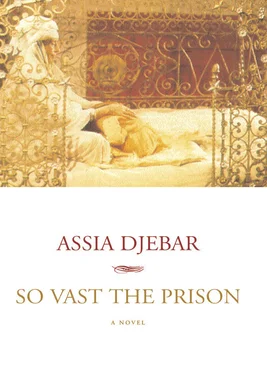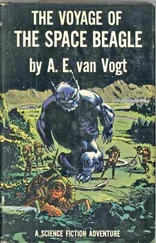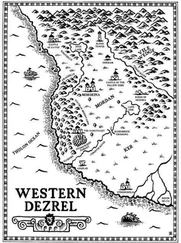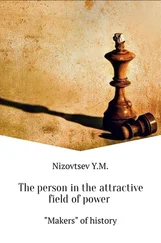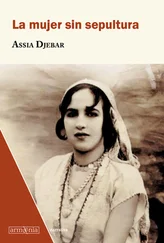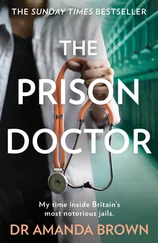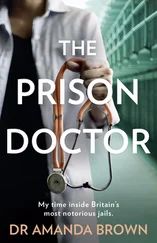So this time, accompanied by her daughter, she went back to her father’s home. She stayed there until the next day, Friday. Saw to Ferhani’s prayer … Then, seven days and seven nights later, she heard herself say to him as well as to his wife who sat beside him, radiant, “Forgive me, both of you! As God is my witness I would like to live my whole life beside you! And you are my daughter’s true guardians! But …”
And she stopped, intimidated.
“What do you want, then, daughter?” father Ferhani exclaimed in a gruff voice, giving his wife who was just as surprised, a questioning look.
“I miss the mountains, and I like being at the zaouia so much! I want to go back up there and probably live there!” She sighed.
Soon afterward, Fatima, her daughter in her arms, left the city in a barouche .
A MONTH BEFORE filming began, after two days of looking for locations, I got out of the car with the assistant director and went toward the farm: sheds and solidly built houses, all buried, however, behind any number of reed hedges. It was a beautiful day.
I went around the main house. Behind it and beyond a hedge of Barbary figs a large wasteland went down to the sea on the other side. There, among the pebbles and red rocks, a panorama of Chenoua mountain met one’s eyes: a wide view with the isolated mountain jutting out like a gigantic ship over the deep bay. Nobility of lines, majesty, with a sort of modesty to its various colors, and on the left, hills fading off toward the interior plain: Chenoua — a screen, almost like one in a theater, standing in front of my family’s mountains, where I have been traveling now for four months already.
I wanted this flat, open stretch to be like a balcony out over the calm and everyday countryside that the couple in the film story could see. Luckily from here one cannot make out the new patch of white, the tourist village built ten years ago.
Up behind me, surrounded by peasants, the chauffeur and the assistant director are waiting for me. It is four in the afternoon: alone here, my rendezvous is with this space. It is the space of my childhood and of something else … perhaps the space of this fiction to be created. Four o’clock in the afternoon: not even Camus and his étranger come to mind.
Alone I walk across this shelf. I hide my excitement by walking athletically, in sudden great strides (I am glad I have long legs for walking energetically while everything inside me churns and boils).
On this November day the air is soft and the end of autumn takes on intense hues, almost those of spring, and I am happy. I neither hide it nor show it. Not yet. I neither burst out into dancing nor yeild to the violent desire to dissolve, to fly away and disappear. Oh, these months of fierce chastity (just as fierce as were my years of sensual love)!
And thus it all began. Not the first period of quiet investigation: the endless whispering conversations with the old women of my tribe, the questions that were misleadingly banal, the words of my childhood language.
Everything really began this first day on the farm, everything. Because as I found my everyday space, this film’s existence became no longer theoretical but present. Though you might not think so, this freedom.
This space, in actual fact, is like me. So, I think, begin a film story, when the space that is right for it is really found. Go all around this space. The way they used to make the walls of the city first and then — an hour later, a day later — build the city in the middle.
So this November day my own city — that is, the house in which my three characters, Lila, Ali, and their daughter Aïcha will live — is founded.
I went back up to the hedge of fig trees encircling the main house. Hamid, the assistant director, is in lively negotiations with the people living there, fishermen or peasants from the nearby cooperative, in case I intend to shoot on location. I leave them. I say that the view is beautiful. I go to a door in the back. Silhouettes of women staring at us between two reed hedges. Greetings. They invite me in. Then I have my second flash of inspiration, just as secret, not very expansive.
Three women in rooms without electricity. An infant cries sporadically. And I, feeling my way around until I get used to it.
The mother, who is probably forty, looks to be fifty or older. Stern, with well-balanced features, tall; her smiling manner has a touch of reserve. She seems attentive to whatever might happen at the edge of her gaze. Two other women, a young girl — sixteen years old, with plump cheeks, named Saïda, who later will be Djamila in the film, the couple’s friendly neighbor — and another woman, whose beauty would strike any visitor.
I never knew her name. I will call her “the unknown woman at the farm,” or “the Madonna.” She was scarcely more than twenty; her balanced features were disturbing, with such a pure bloom, yet seeming, at the same time, tarnished with shadow … a half smile, not aware herself of her own sadness. The Madonna: whenever I saw her after this she was holding a baby in her arms, a sickly baby. How can I portray her first appearance, how it extended into each of the forty days spent at the farm? Forty times as I came or went through a side door (a door only I was allowed to use) between the rooms rented for the film and the rest of the house, I would see again the slender silhouette. She held herself up straight, with only her shoulders a bit sunken as if the threat of tuberculosis hung over her. The Madonna.
Sometimes with her breast out, her baby whimpering (the baby I did not look at but whose illness I felt, I heard), she would smile at me. Forty times I looked at the dazzling purity of her face, her clear gaze, her cheeks still rosy with youth, and that hollow between her shoulders.
I lingered over the Madonna. Perhaps because, several days before we started filming, I knew for sure that she would not figure in the film. By chance I had come upon a family willing to collaborate with the image and the machinery we brought, whether out of economic interest or out of a real openness (a rather rare event in the new rural world). Afterward I wondered to what extent the mother was the dominant influence. She had guessed, confident in herself and her authority over her family, that she could extract some profit from us with no moral damage. I also think that the mother had instinctively judged me and the new role I represented for them, the threat I was in a position to keep in check …
So I quickly knew that the Madonna would only exist for me, outside the “shot,” that her image could not be bought … It was as if, right from the start, she held on to her integrity for two reasons, as if her beauty concentrating the family secret had to remain inaccessible to us … There was no violent refusal when this happened, not even the Islamic prohibition that one might have expected would be aggressive. “No.” It was a calm no that the mother would put to me, and the only reason she gave seemed obvious: “No, because her husband, my son, works in the capital and is not here.”
I did not insist. I knew instantly that no would be no. Even though, during this period of cold heat prior to shooting the film, I knew that I would get everything (“everything” in my hunt for images). I was persuaded that insistence, friendliness, and solidarity, an appeal to reasonable interest, would work, and “any method” seemed honorable to me. But the crux of my confidence lay finally in this drive to make the film concrete; all the thankless or exalting work consisted of putting the documentary materials into shape. More precisely, rediscovering its original form and thus redoing mine.
I go back to the Madonna of the shadows, to her baby who nurses but is sick. She could have been the first to say, with that shy smile she gives me, “I represent all the women here that your machines will not define. I am the fringe of what is forbidden, and I like you.”
Читать дальше
